Consolidation liquidation is a different type of liquidation we experience compared to other types of foundation liquidation.
There are essentially two types of settlements.
- Immediate processing
- Time-dependent billing, i.e., consolidation billing
Let's look at what soil compaction is.
Consolidation
When foundation construction is completed (applying additional load), pore water pressure in the saturated clay increases because the hydraulic conductivity of the clay is very low. It takes time for excess pore water to evaporate and the stress transferred to the soil skeleton to increase.
This gradual increase in effective stress in the clay layer results in settlement over time, known as consolidation settlement.
Additionally, soil compaction can be carried out as follows.
The application of loads results in volumetric compression of the underlying soils. When the soil is saturated, pore water pressure increases immediately after loads are applied. Consolidation is the process in which volume reduction occurs due to the expulsion of water from the water pores.
The dissipation of excess pore water pressure is accompanied by an increase in effective stress and volumetric strain. Cohesive soils have much lower hydraulic conductivity, which is why compaction takes much longer.
Soil consolidation occurs in two phases.
- Primary Consolidation Settlement
- Secondary Consolidation Accounting
More information about these two will be discussed in detail in the last part of this article.
Some important aspects of consolidation settlement are as follows.
- Time Dependency Process
- It is a three-dimensional process, as water movement can occur in any direction. However, the soil boundary in the lateral direction and consolidation can be considered vertical and one-dimensional.
- Soil permeability influences its compaction.
Let's discuss some terms to understand consolidation.
terminology
Primary consolidation
The compaction of compressible soils occurs in two previously defined phases.
Primary consolidation is a process of dissipation of the increase in pore water pressure due to the action of loads on the soil layer and the increase in effective stress in the soil skeleton.
This leads to a change in the volume of the soil skeleton. The liquidation caused by volume reduction is called primary consolidation liquidation.
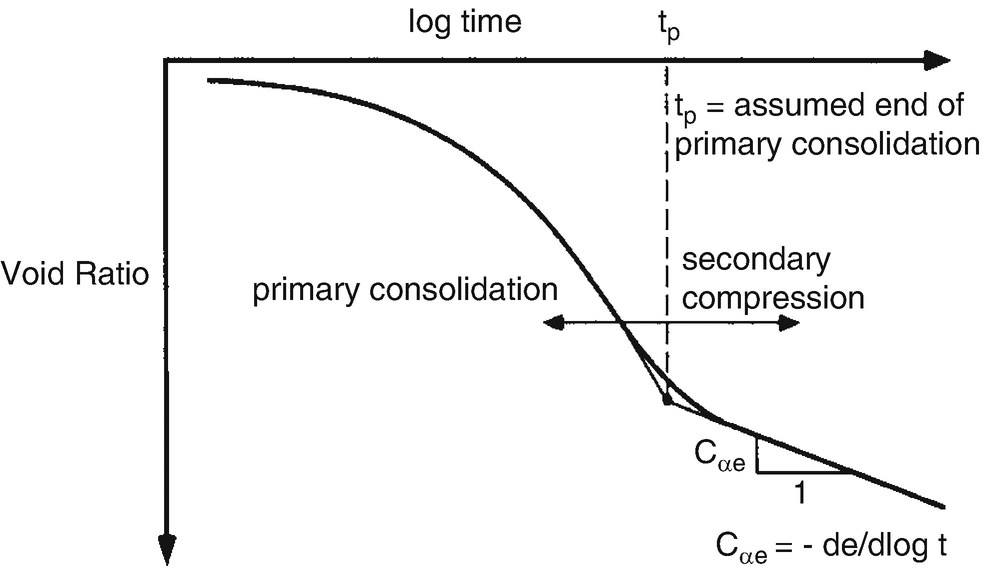
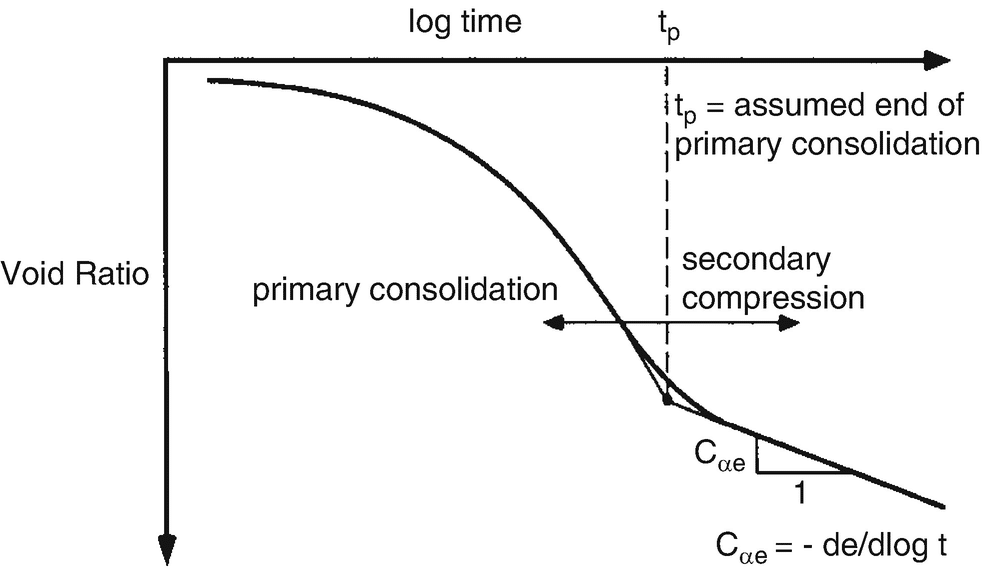
Secondary consolidation
Secondary solidification occurs after primary solidification, that is, with the reduction of the increase in water pressure in the pores.
During secondary consolidation, the soil skeleton is reorganized, reducing pore water pressure and reducing volume.
At this stage, settlement occurs through secondary consolidation.
This process is also known as creeping.
Overconsolidation
Overconsolidation: The comparison of the stress acting on the soil at the current stage with the highest stress the soil is experiencing.
If the current stress is lower than that exerted in the past, the solid is overconsolidated.
OCR Overconsolidation Rate
OCR is used to determine the state of soil compaction relative to the past.
OCR = Largest Soil Load / Current Soil Load
OCR can interpret the applied load as OCR times less than the load already applied during consolidation.
It acts as a security factor against future consolidations.
Normally compacted soil
A soil that is currently under the greatest stress is called a “normally consolidated soil” and has an OCR of one.
i.e.
Maximum soil load = Current soil load
The greatest overburden pressure through the soil (weight or tension exerted by the other layers above) remains the same as now.
Pre-consolidation pressure
The maximum effective vertical overload stress to which a given soil sample has been subjected in the past.
Pre-consolidation pressure is also expressed by other terms such as pre-consolidation stress, pre-compression stress, pre-compression stress and pre-compression stress.
Degree of consolidation
Degree of consolidation = degree of consolidation at a given time with a soil mass / total degree of consolidation achievable under the given loading conditions.
For a clay layer this can also be written as follows.
Degree of consolidation = settlement of the clay layer at time t after application of the load / maximum consolidation settlement that the clay layer suffers under a given load .
Soil types are subject to consolidation settlement
The following Soil types are vulnerable to consolidation agreements.
- volume
- Organic soils
- Silty soils
Now let's move on to the tropic of consolidation
Primary consolidation
The definition of primary consolidation is explained above in the Terminology section.
Let's calculate the primary consolidation billing method
There are two different stages of soil.
- Normally compacted soil
- Above consolidated ground
It is necessary to evaluate soil compaction based on the above conditions.
Calculation of the consolidation settlement of normally consolidated soil
Simply put, normally consolidated soil experiences the greatest stress from the past to today (currently).
First, let's look at the distribution of stresses under the foundation, where there is a layer of clay. Most importantly, we take into account the average stress in the clay layer when calculating settlement.
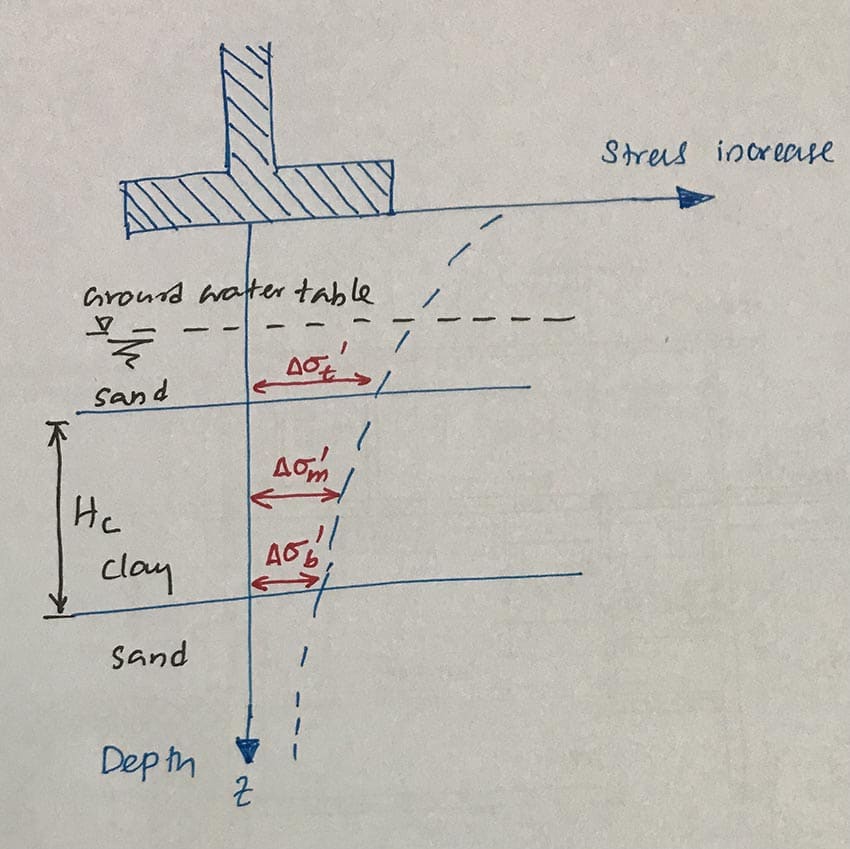
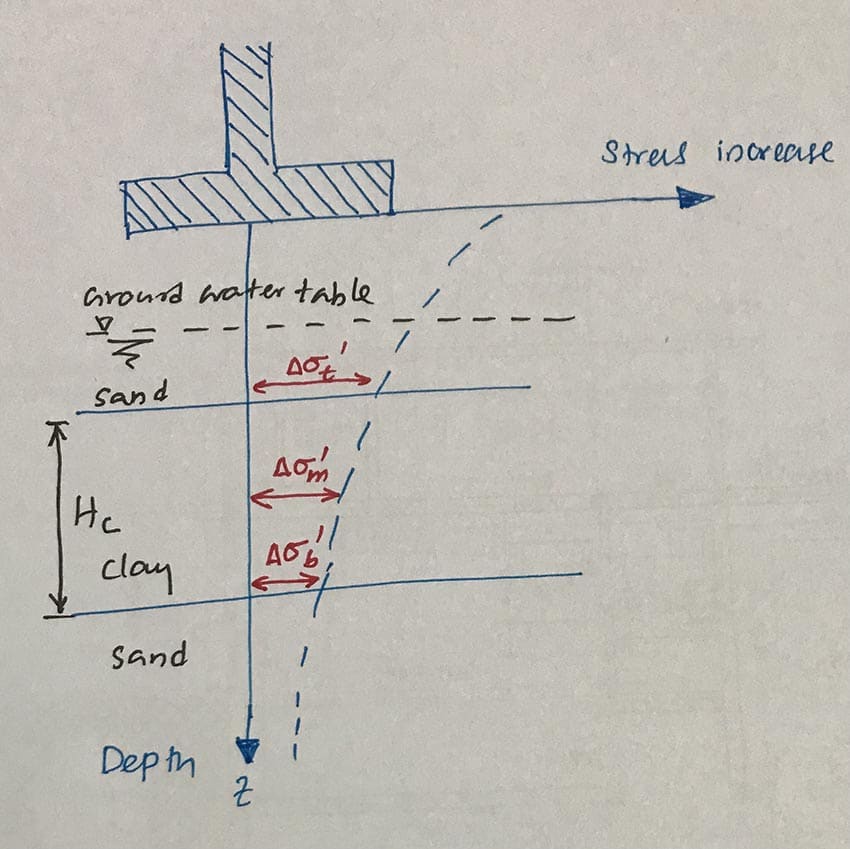
The average pressure rise in the clay layer can be calculated as follows.
Δσ' a V = (1/6)(Δσ' T +Δσ' M +Δσ' b )
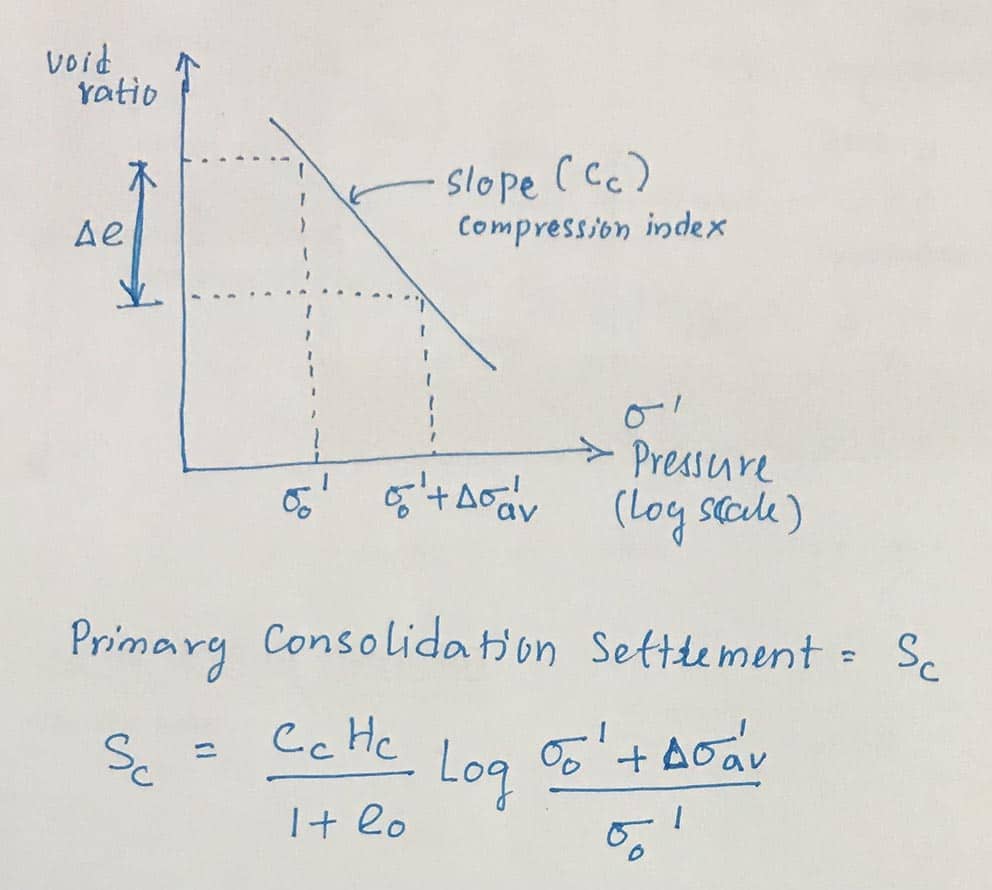
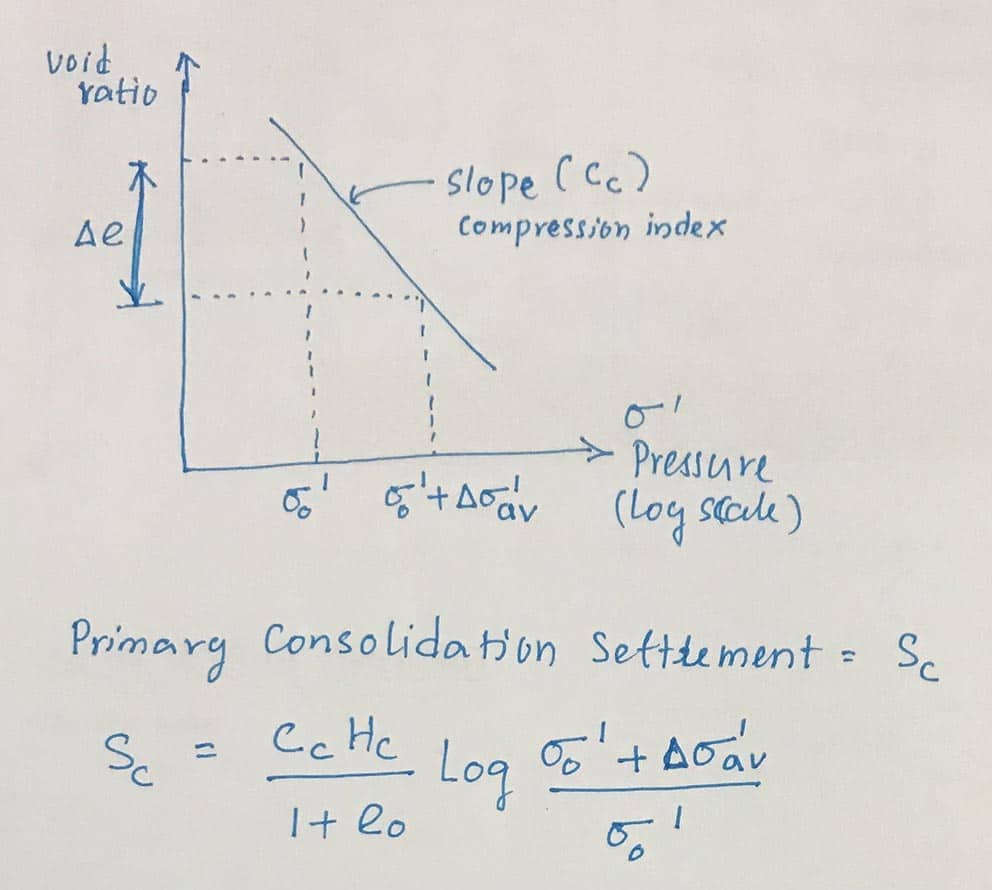
Foundation settlement can be calculated using the above equation. For more information, you can refer to the calculation example at the end of this article.
Calculation of the consolidation settlement of superconsolidated clayey soil
Depending on the applied load, a settlement calculation can be performed.
Case 01: The applied voltage is lower than the voltage before solidification
Case 02: The applied voltage is greater than the voltage before solidification
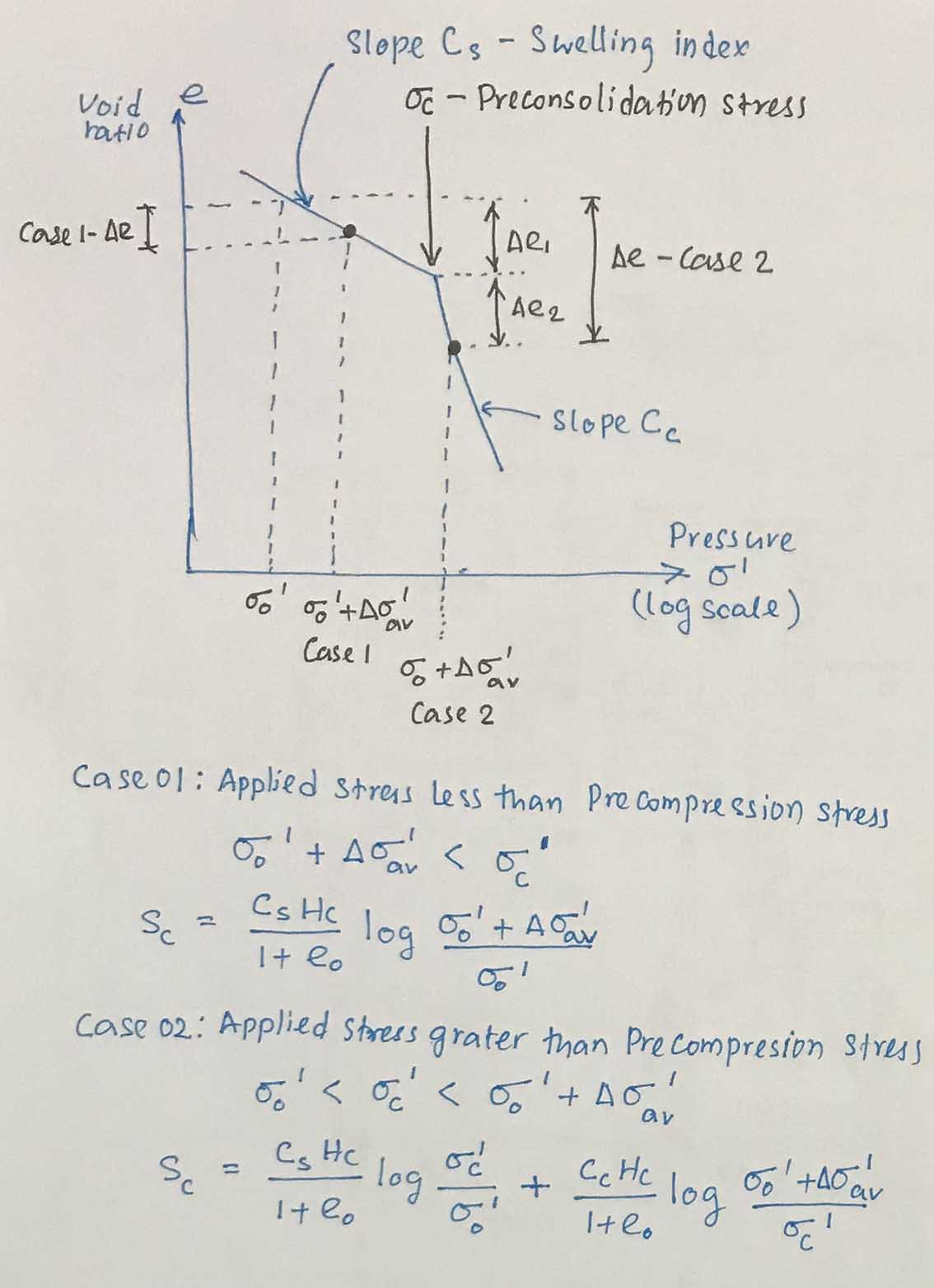
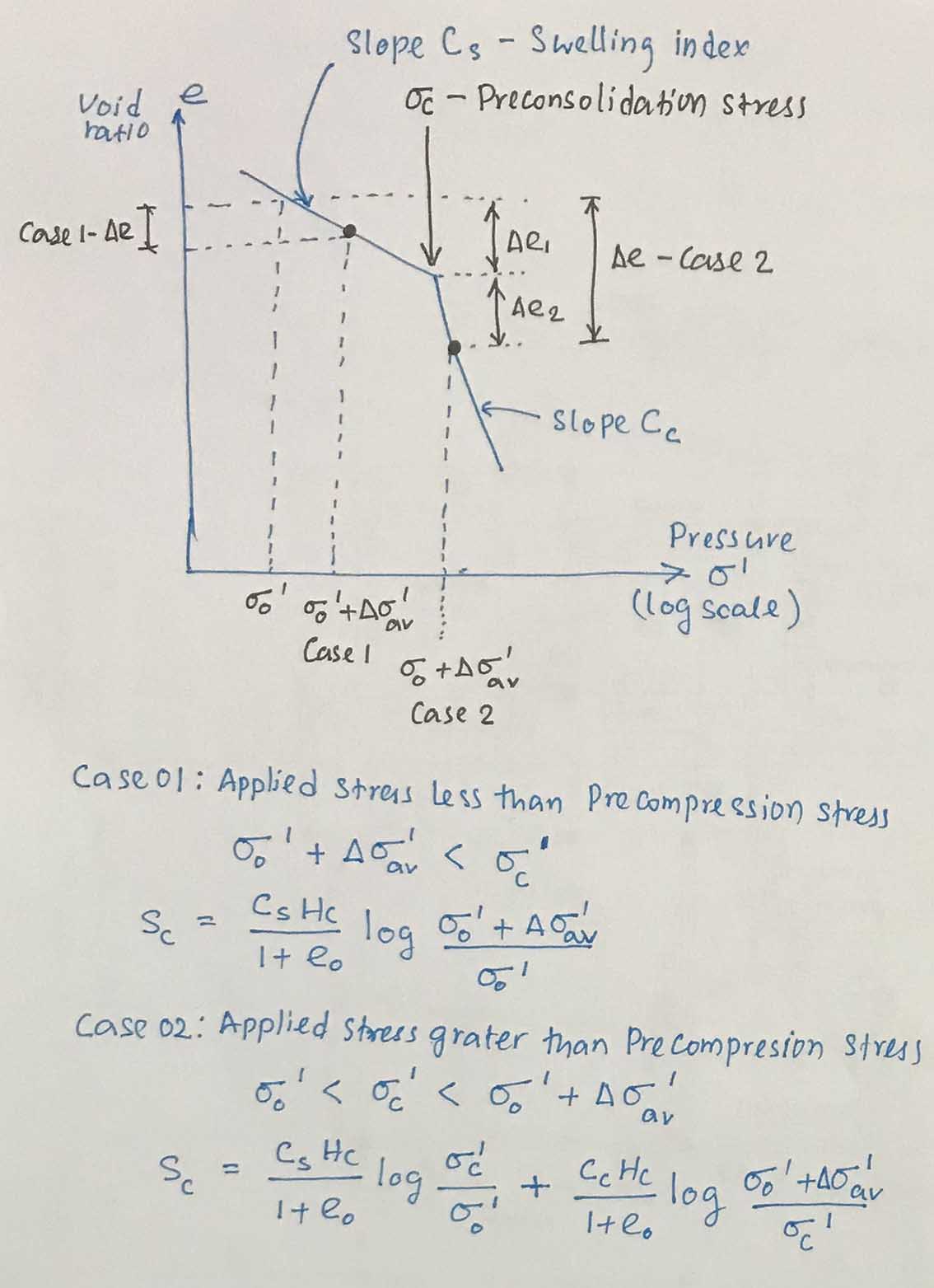
Secondary consolidation
Secondary consolidation settlement occurs when the excess pore water pressure that developed immediately after load application is completely relieved.
Secondary consolidation refers to the settlements that arise from the plastic adjustment of soil structures at the end of primary consolidation.
Secondary consolidation can also be explained as sliding and realignment of soil particles under sustained load.
Secondary consolidation can be calculated as follows.


The following factors should be taken into consideration when evaluating secondary consolidation accounting:
- Organic and highly compressible soils are more susceptible to greater secondary consolidation
- Secondary consolidation is less significant in overconsolidated inorganic clays because the secondary compression ratio is very low.
Types of Tests to Determine Consolidation Accounting
- One-dimensional consolidation test
- Edometer test
- Incremental Loading Edometer
Worked example: Calculation of primary consolidation settlement in normally consolidated clay
The following figure shows the work sample information
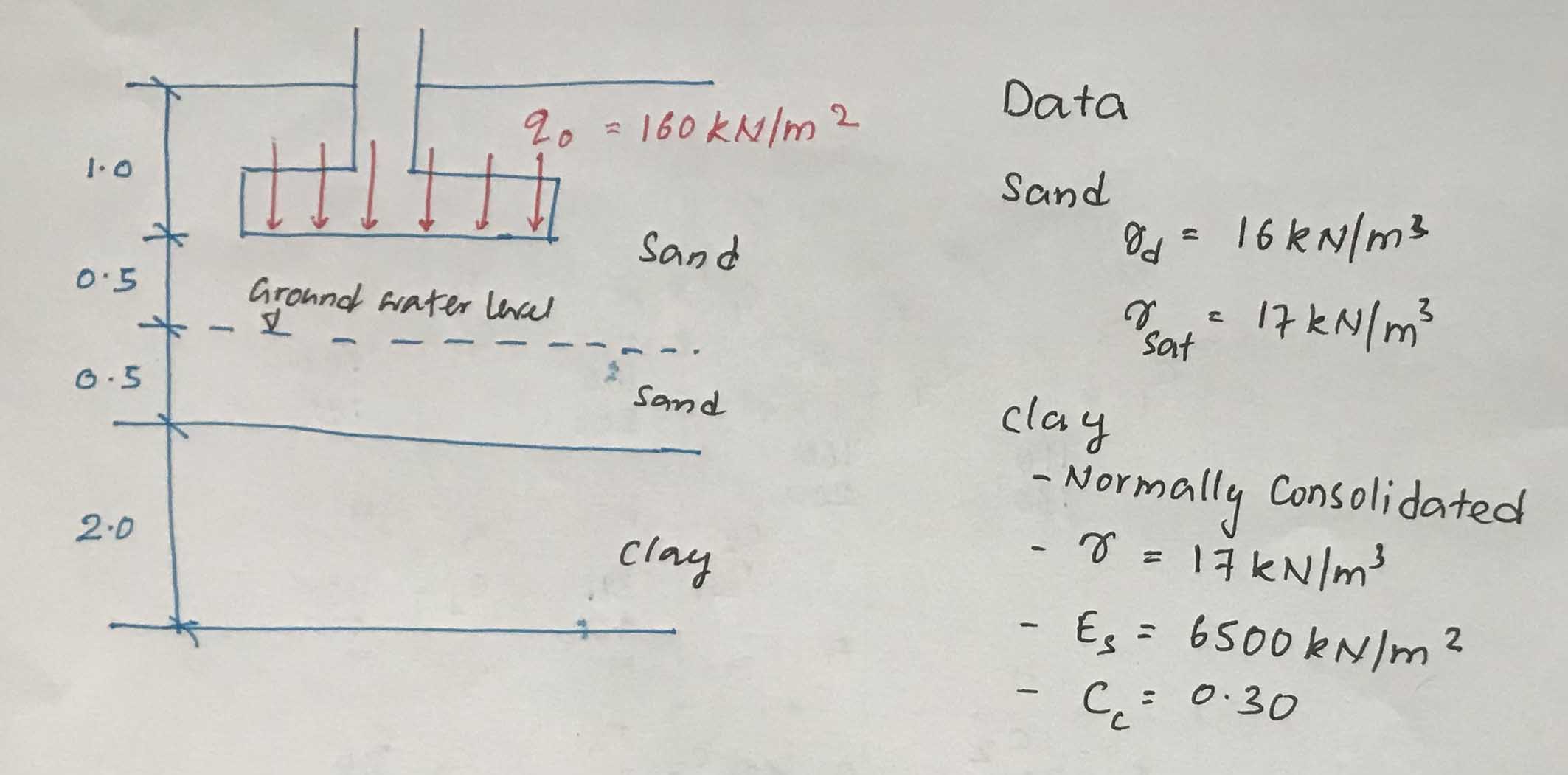
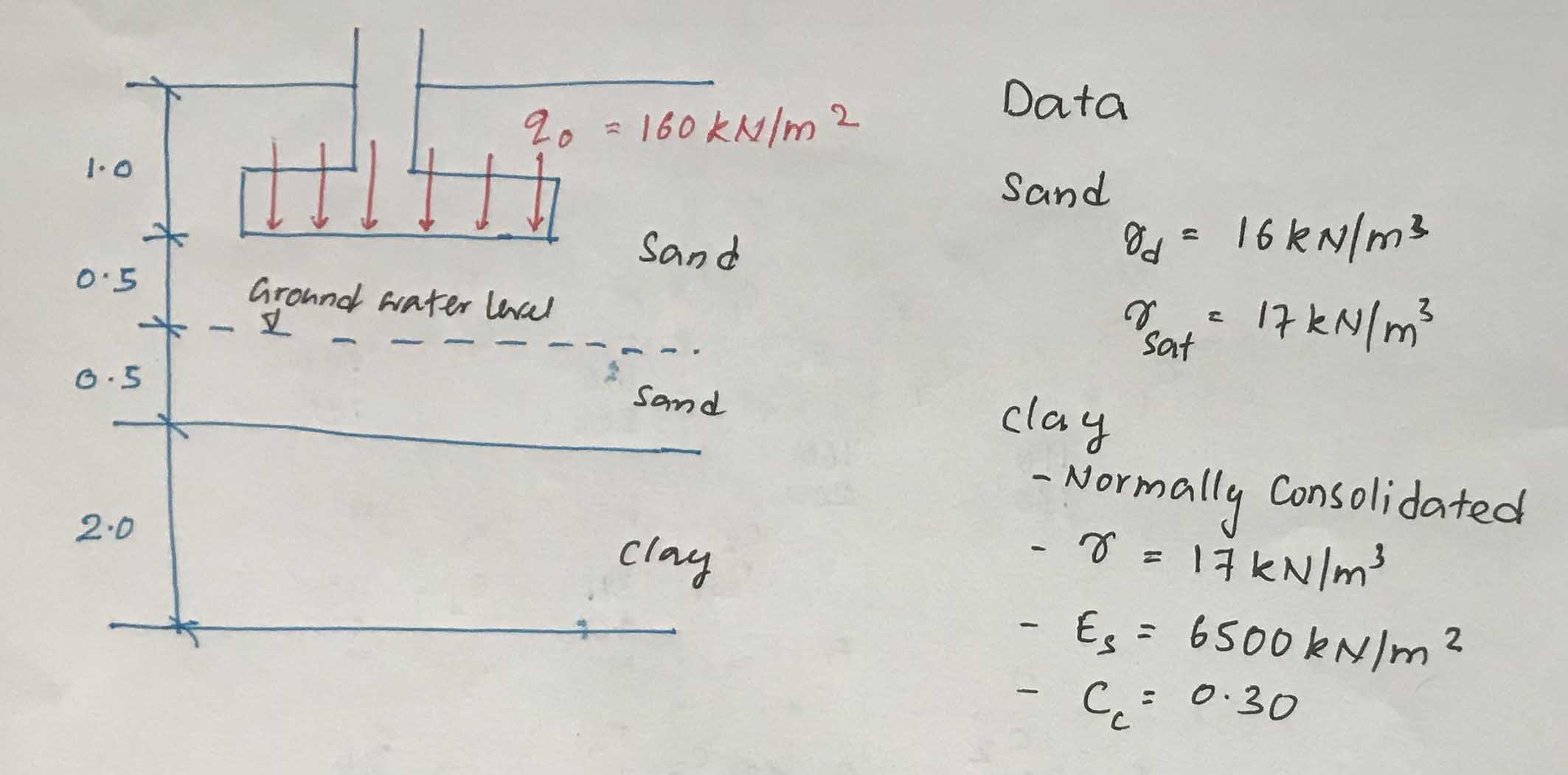
Soil compaction (usually compacted) can be calculated using the following equation, explained in this article.
S C =C C H C /(1+e 0 )log((σ' 0 +Δσ' um V )/σ' 0 )
Where
S C – Consolidation settlement in normally consolidated clay
C C – Compression index – determined based on laboratory tests
H C – Height of the clay layer
t 0 – Original pore content of the clay layer – to be determined through laboratory tests on undisturbed samples
σ' 0 – Soil tension in the middle of the clay layer
Δσ' um V – Average increase in stress in the clay layer due to foundation load
Calculate the soil tension (σ' 0 ) in the middle of the clay layer
σ' 0 = 1.5×16 + 0.5(17-9.81) + 1x(17-9.81) = 34.785 kN/m 2
Calculate the increase in soil stress due to foundation load at the average height of the clay layer
Δσ' a V = (1/6)(Δσ' T + 4Δσ' M +Δσ' b )
The method of calculating stress under the foundation is more laborious. However, in the book “Principles in Foundation Engineering” there is a simplified table that can be called a quick calculation. The method of calculating the stress under the foundation can be carried out using the following equation.
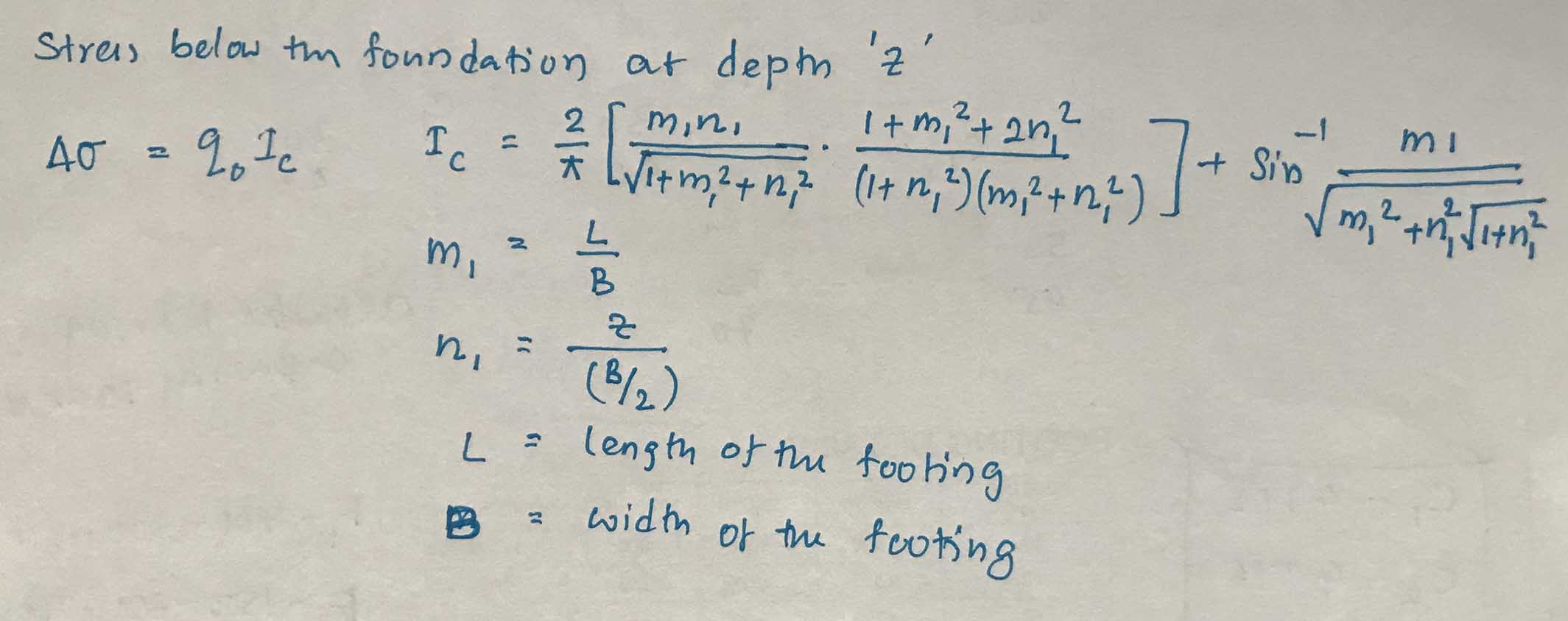
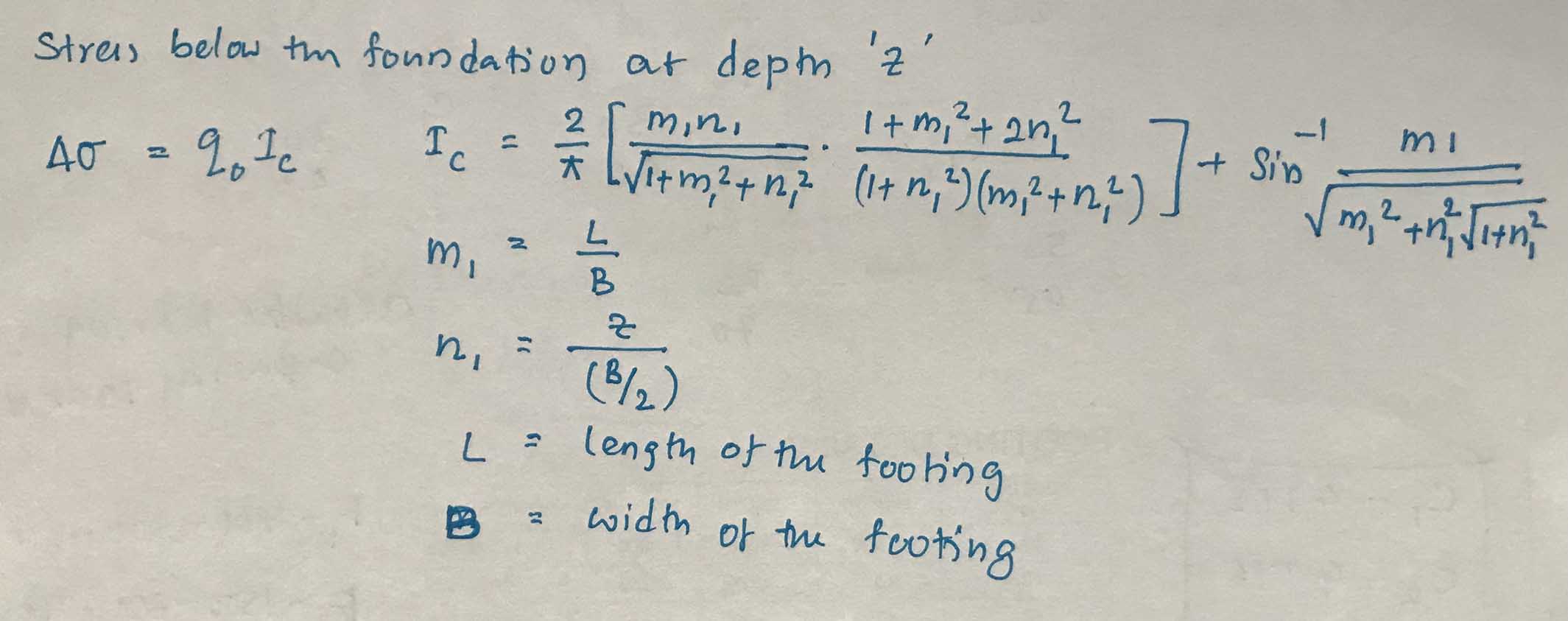
Consider the width and length of the foundation as (LxW = 1mx2m). Depth “z” is measured from the base of the foundation.
P 0 = 150kN/m 2
t 0 – 0.8
| stress | M 1 | for example | N 1 | I C | P 0 EU C |
| ∆σ' T | two | 1 | 1 | 0.800 | 120 |
| ∆σ' M | two | two | 4 | 0.190 | 28.5 |
| ∆σ'b | two | 3 | 6 | 0.095 | 2:25 p.m. |
Now let's calculate the increase in soil stress.
Δσ' a V = (1/6)(Δσ' T + 4Δσ' M +Δσ' b )
Δσ' um V = (1/6)( 120 + 4×28.5 + 14.25 ) = 41.375 kN/m 2
Calculate billing
S C =C C H C /(1+e 0 )log((σ' 0 +Δσ' um V )/σ' 0 )
S C = 0.3×2/(1+0.8) log((34.785+41.375)/34.785) = 0.113 m = 113 mm
Primary consolidation of normally consolidated soil can be calculated as described above. Likewise, secondary hardening can also be calculated using the methods discussed previously.
References
Basic Construction Basics
Internet

